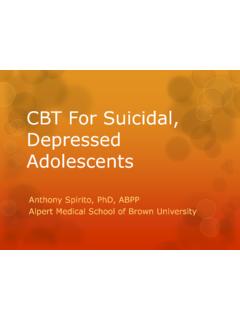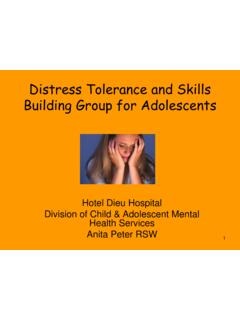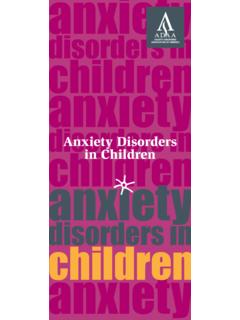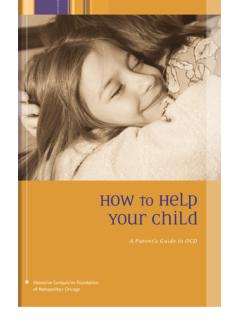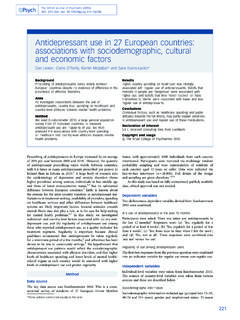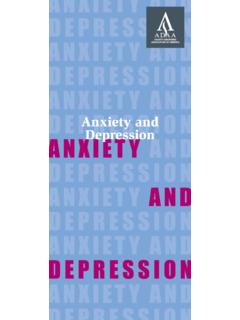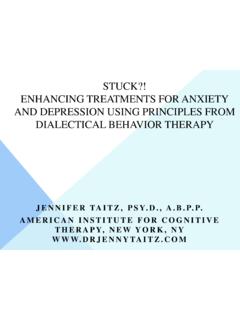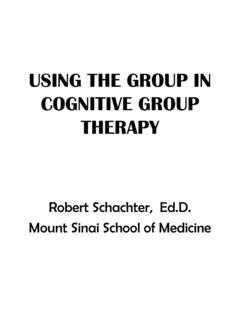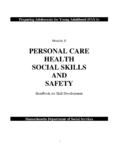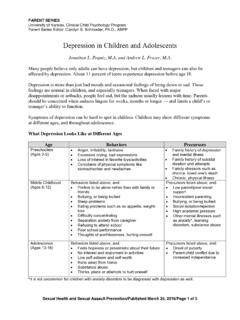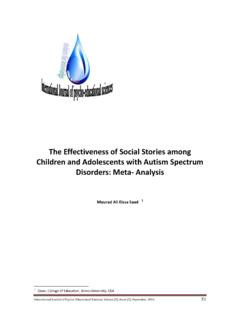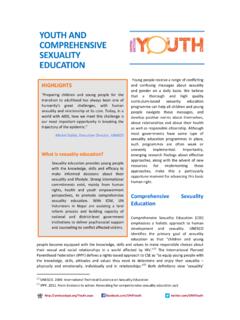Transcription of INTERPERSONAL PSYCHOTHERAPY FOR DEPRESSED …
1 INTERPERSONAL PSYCHOTHERAPY FOR DEPRESSED ADOLESCENTSL aura Mufson, University College of Physicians and Surgeons and New York State Psychiatric InstituteADAA MeetingMiami, FloridaApril 9, 2015 Conflict of Interest Laura Mufson, receives royalties from book: INTERPERSONAL PSYCHOTHERAPY for DEPRESSED Adolescents, second edition,2004. Guilford PSYCHOTHERAPY Developed by Gerald Klerman, and Myrna Weissman, Originally developed for adult outpatients: DEPRESSED Nonbipolar Nonpsychotic Time-limited treatment (16-20 sessions for adults) Theoretical Underpinnings Attachment theory People experience distress when disruptions in attachment occur (Bowlby, 1978) INTERPERSONAL theory Poor attachment leads to inadequate or maladaptive INTERPERSONAL communication patterns that may lead to difficulties in current relationships (Sullivan, 1953; Kiesler, 1979) Social Theory Poor social support can contribute to the development of depression by influencing the ability to cope with INTERPERSONAL stress (Meyer, 1957.)
2 Coyne, 1976)4 BASIC PRINCIPLESB asic Premise of IPT Depression occurs in an INTERPERSONAL context Depression affects relationships and problems in relationships affect moodGoals of IPTE ducate about link between symptoms and events in relationshipsDecrease depressive symptomsImprove skills in addressing INTERPERSONAL problems that may be contributing to or exacerbating the depressionStrategies of IPTI dentify problem area(s)Focus on current relationshipsFocus on INTERPERSONAL nature of the problemHelp patient master INTERPERSONAL context of the depressionDepression Conceptualized in IPT1. Symptom Formation*2. Social Functioning*3. Personality*role for IPTD istinguishing Features of IPT-A Limited sick role 12 week duration Involvement of parents Use of the telephone Liaison role between schools and families Use of grief problem area for normal grief reactionsPrimary Components of IPTE ducation Psychoeducation Limited Sick Role INTERPERSONAL Inventory Treatment ContractAffect Identification Labeling Emotions Clarification of Emotions Facilitating Expression of Emotions Monitoring of EmotionsInterpersonal Skills Building Modeling Use of Therapeutic Relationship as Model Communication Analysis Perspective Taking INTERPERSONAL Problem-Solving Role PlayingParent InvolvementIn all 3 phases of treatment.
3 Initial Diagnosis, psychoeducationand treatment explained Middle to improve communication and problem-solving with adolescent as needed Termination-Discuss adolescent s experience in treatment, effect on family, and need for further treatment12 Three Phases of Treatment Initial Sessions 1-4 Middle Sessions 5-9 Termination Sessions 10-12 Initial PhaseGoals of Initial PhaseIdentify and diagnose symptomsEducate about depressionAssign limited sick roleExplain theory of IPT-AConduct INTERPERSONAL inventoryIdentify the problem areaSet treatment contractInitial Parent Session Held either contiguous to first session with teen or in between session 1 and 2 Tasks: Psychoeducationabout depression Correct misperceptions about the teen s illness Discuss issue of confidentiality Discuss their role in the treatment as needed Encourage them to work with therapist as the expert on their teen Discuss the philosophy and goals of the therapyReview of Depressive Symptoms Use the Hamilton Rating Scale or Children s Depression Rating Scale as a guide Occurs at the beginning of every session throughout treatment Initial session involves complete review Later sessions: Review previously endorsed items Always monitor suicidal ideation and/or behaviorMood Rating Teach the adolescents to rate their mood on a scale of 1 to 10 (1=best they could feel, happiest and 10= worst they could feel or saddest) At beginning of each session the adolescents give.
4 Average mood rating for the week Best mood rating for the week Worst mood rating for the week Assess what has occurred to be the worst and best mood rating and begin link between INTERPERSONAL events and changes in Sick RoleGive the teen the notion of having an illness -can liken it to having pneumoniaAffects they way they function in their day to day life ( , drop in grades, less interest in after school activities)Encourage normal participation in activitiesCan revise performance expectations while depressedEncourage parents to be less critical of performance and more supportive of participationInterpersonal Diagnostic Assessment In-depth assessment of patient s most significant relationships - INTERPERSONAL inventory Identify those issues most closely related to onset and/or persistence of depression Primary informant is adolescentCloseness CircleProvides a visual diagram of the adolescent s relationships that will be discussed in the INTERPERSONAL inventoryAsk adolescent to place important people in his/her life in the closeness circleNote people who are missing from the circleJessicaMomCarlaDadGMJohnLisaUncleB rianExample of a Closeness CircleInterpersonal InventoryFrequency, content.
5 And context of contacts with the personTerms and/or expectations of the relationship Whether or not the relationship has met the expectationsPositive and negative aspects of the relationshipIdeas regarding the effect of that relationship on other relationships and vice versaPositive or negative patterns of communicationAny significant life events that may be related to depressionQuestions About Specific People What types of things can you talk to _____ about? What do you like about your relationship with _____? What don t you like about your relationship with _____? Do you get into arguments often with _____? How do you feel when you are around _____? Has your relationship with _____ changed since you ve been DEPRESSED ? How? What would you like to change about your relationship with _____?Questions Related to Problem Areas Is it difficult for you to make friends? How so? Do you have difficulties making transitions, such as from junior to senior high? Have you lost anyone significant in your life recently?
6 Have there been any recent changes in your life? What do you think is most closely linked with your depression?Problem AreasInterpersonal Problem AreasBased on INTERPERSONAL inventory, identify INTERPERSONAL problem area(s) to focus on in treatment: Grief Role Transition Role Disputes INTERPERSONAL DeficitsGriefThe identified problem area when the teen has lost someone close to him or herTeen describes the onset of symptoms as being associated with this death The death does not need to immediately precede the depression Depression can be a delayed reaction to this lossInterpersonal Role TransitionThe identified problem area when teen or family is having a difficult time adjusting to a life change that requires a new roleRole transitions can occur because of developmental changes or other life changes, such as parents divorcing, moving, or someone in the family being illA role transition can lead to or exacerbate depression and depression may make teen less equipped to cope with the transitionInterpersonal Role DisputesThe identified problem area when teen and other have different expectations for the relationship which leads to frequent conflictsDisputes in adolescence are frequently with parents and may involve more than one issueA dispute exacerbates or precipitates depression and irritability and withdrawal may intensify the disputeInterpersonal DeficitsThe identified problem area when teen lacks the social and communication skills to initiate and maintain relationshipsTo some extent, all DEPRESSED teens have INTERPERSONAL deficits, but this problem area is really for adolescents for whom this is the key issueMild INTERPERSONAL deficits may precede the depressionDepression exacerbates the social isolation which increases the depressionProblem Area Formulation A hypothesis to address several questions.
7 How did the patient come to be the way he or she is? What factors are maintaining the problem? What can be done about it? Should validate the patient s experience and way of understanding the problem Results in a mutually determined focus for treatment Provides a plausible rationale for the use of IPT-A for the problemConclusion of Initial Phase Outline adolescent s and parents role in treatment Identify treatment goals Clarify expectations for treatment Establish practical aspects of treatment Set obtainable goalsMiddle PhaseMiddle Phase SessionsBegin each session with review of depression symptomsWork collaboratively with adolescent to clarify the problemWork on INTERPERSONAL communicationIdentify effective strategiesAssist in development of skills for negotiating relationshipsIdentifying INTERPERSONAL Events How have you been since we last met? For the feeling teen need to review the day or week in great detail to identify the INTERPERSONAL event For the event teen need to dissect the behavior following the event and discuss it as a symbol of feelingsInterpersonal EventsTasks of Therapist Monitor depressive symptoms Help patient discuss problem area Facilitate patient s self disclosure Meetings with parents and school Establish alliance with parents Focus sessions on problem areaGeneral StrategiesTechniques in the Middle PhasePsychoeducationExploration and expression of feelingsClarification of expectations for relationshipDevelopment of communication skillsUse of therapeutic relationshipRole playingWork at homeExploratory Techniques Open-ended questions Non-directive statements/supportive acknowledgement Targeted questioningUse with AdolescentsNeed the chance to be heard and have a sense of control over treatment situationClearly also require structure to focus their experiencesThe challenge is to find a balance
8 Of directive and non-directive techniquesNon-DirectiveDirectiveCommunic ation AnalysisGoals are to help the adolescent understand: The impact of his/her words on others The feelings he/she conveys with verbal and nonverbal communications The feelings that generated the verbal/nonverbal exchange The cyclical nature of communication The ability to modify these exchanges and then the affect associated with the relationshipSpecific Questions What did you say? What did s/he say? Then what happened? How did you feel? Was that the message you wanted to convey? How do you think it made _____feel? How could you have said it differently? How do you think _____ would have felt? How would you have felt differently?Decision AnalysisSelect an INTERPERSONAL situation that is causing conflictEncourage the teen to generate possible solutions to the conflictEvaluate the pros and cons of each solutionSelect one solution to try firstRehearse the interaction needed for the first solutionReview the interaction the following week examining either its success or where it didn t work and possible reasons whySpecific Communication Strategies Aim for good timing Use I statements Give to get start off with a positive statement that shows you understand how the other person feels Have several solutions in mind for negotiating Don t give upRole PlayingGoals To give the adolescent a SAFE place to practice new INTERPERSONAL skills ( , expression of affect)
9 To give the adolescent the opportunity for rehearsal and to receive feedback on skills and strategies prior to trying to apply it outside of therapy To improve the teen s social confidenceGuidelines for Role Playing Role playing is an active technique just don t talk about what it would be like to do it act it out Be prepared to initially have to coax some adolescents to do it For anxious teens lead them to it gradually Talk through it first Structure it for them Allow them to play the role they are more comfortable with initially and then switch roles with themHomework Really work at home Explain to teens that they will be experimenting with new skills at home between sessions To be created as needed to support the therapeutic work Developed as an outgrowth of work on a particular problem Tailored to the individual patient and not necessarily strictly prescribed Work at Home Often comes out of a discussion or role play in session Or is assigned to address a particular symptom or issue that continues to be problematic ( , being socially withdrawn) Goals.
10 Help the teens own and internalize the new skills Gain a sense of mastery independent of therapist Improve important relationshipsPurpose of Teen-Parent Session The purpose of the middle phase dyadic session differs depending on the problem area If the problem area does not involve the parent, purpose can be to update parent on progress and to engage parent s support of middle phase work If the problem area involves the parent, purpose is to help the teen and parent communicate in a new way Goal is not necessarily to resolve a problem or reach a solution but to improve the process of communicationProblem Area Specific StrategiesGriefStrategies Educate about and facilitate mourning process Review in detail the lost relationship Describe the events just prior to, during and after the death Discuss patient s relationship with the deceased Promote communication skills so can talk to others about feelings Help the adolescent to find ways to meet new people and develop new social supports to fill the lossInterpersonal Role Disputes3 stages of dispute:1.
